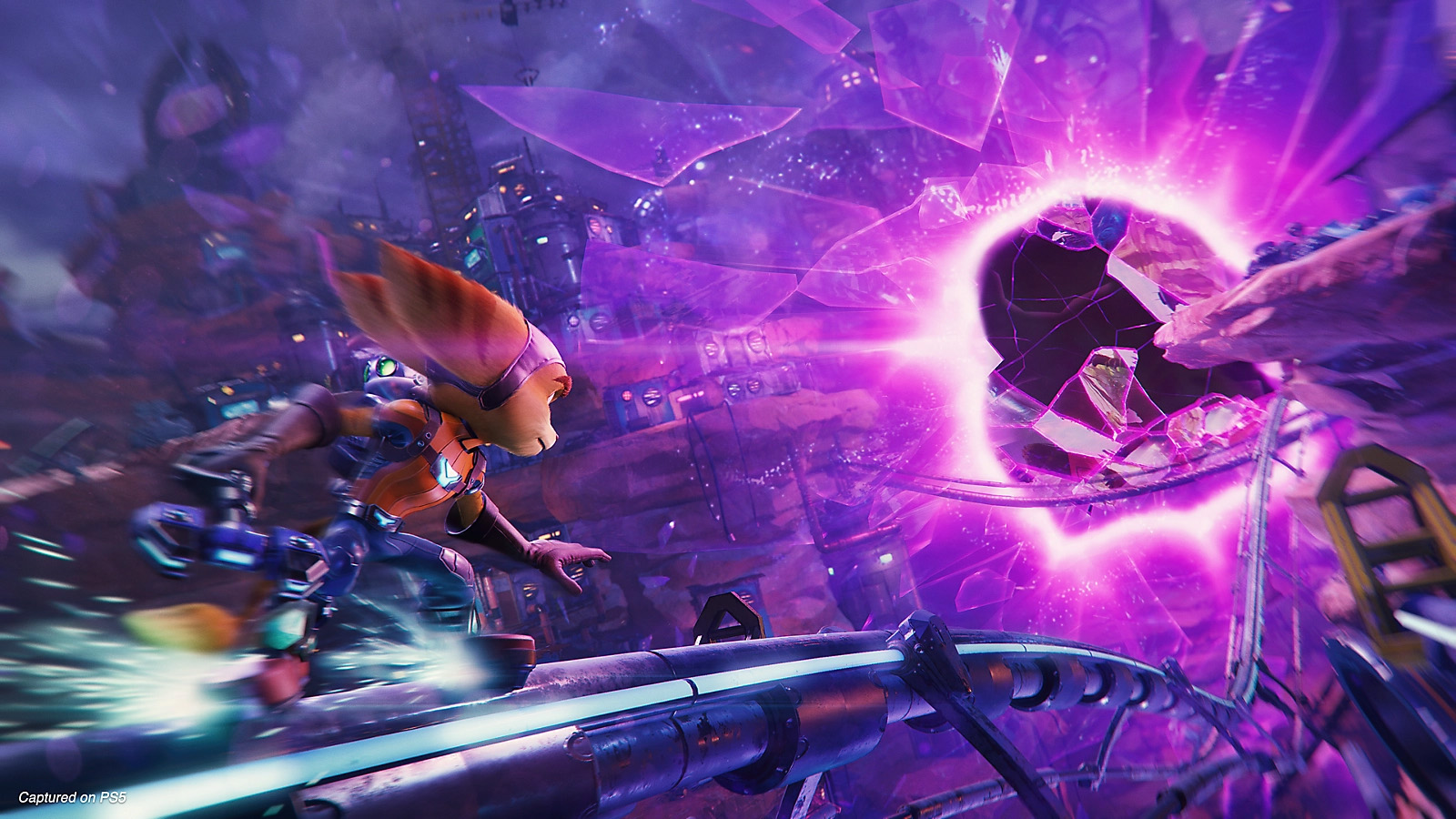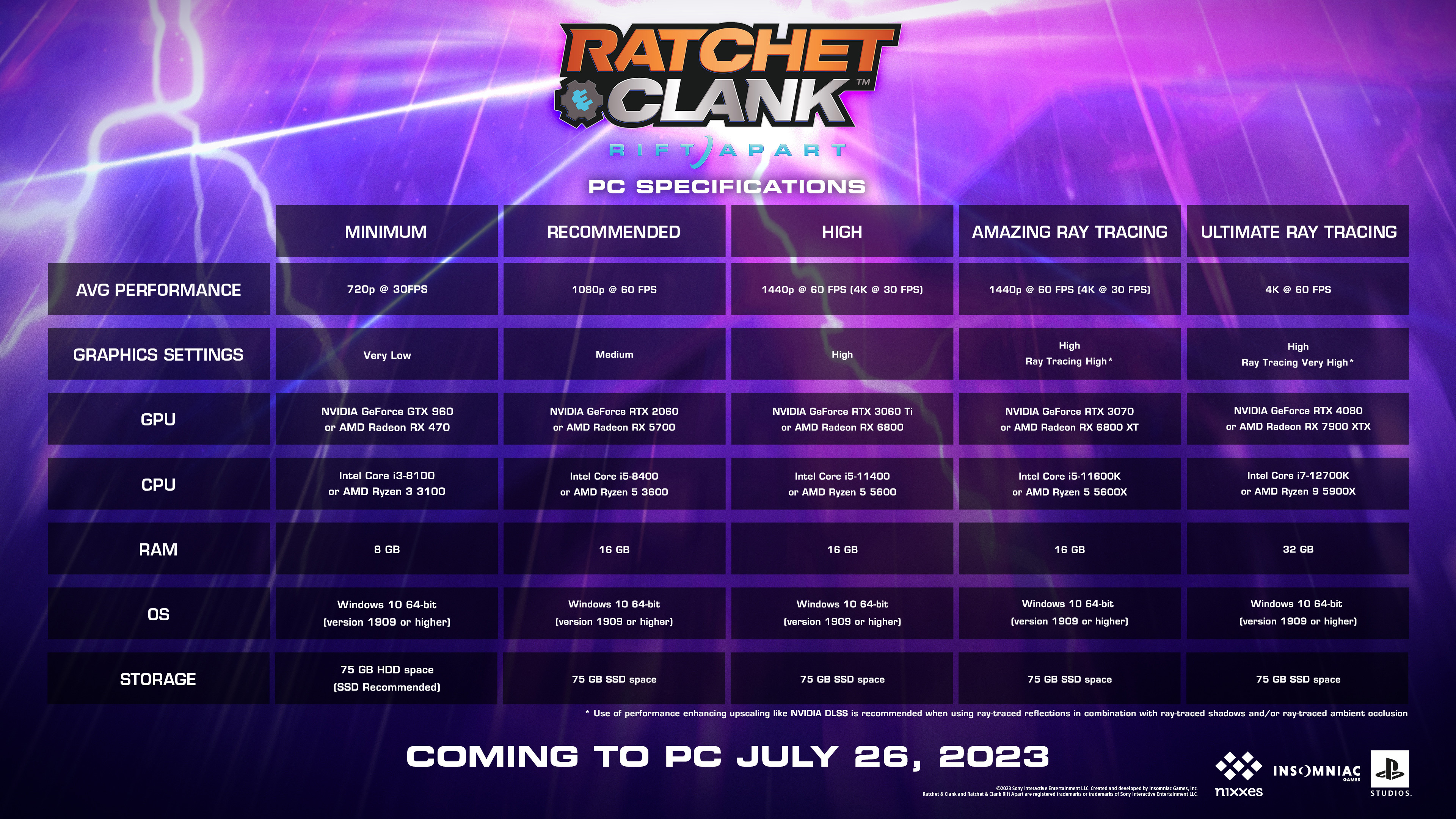'Ratchet & Clank: Rift Apart' Could Be First PC Game With DirectStorage GPU Decompression
GPU decompression is finally making its way to an actual PC game

According to a Steam forum post that was deleted yesterday, Ratchet & Clank: Rift Apart could be the first game to feature GPU decompression when it arrives later this month on PC. But that's not all, according to the developers, the game will be completely dependent on DirectStorage 1.2 and its associated GPU decompression technology to enable instant transitions between dimensions, which is a critical element of the game's mechanics.
GPU decompression was introduced in 2022 as part of Microsoft's 1.1 update for the DirectStorage SDK. The advantage GPU decompression offers is substantially greater loading times compared to traditional methods, by re-routing decompression duties from the CPU to the GPU directly. Benchmarks have proven that GPU decompression can mean the difference between waiting for a loading screen or seeing gameplay changes occur in real time.
However, it has taken almost a year for any game to take advantage of GPU decompression. Technically Forespoken features Microsoft DirectStorage support, however, the game does not have GPU decompression support. Ratchet & Clank: Rift Apart, will likely be the first game to support GPU compression if no other game beats it first.
Ratchet & Clank: Rift Apart is arguably one of the best games to start off the field running with GPU decompression support. The game was one of the first titles to take full advantage of the PlayStation 5's high-speed NVMe SSD and is intrinsically demanding on system storage in ways most other games are not. The game's inter-dimensional gameplay mechanics require the game engine to switch between game worlds extremely quickly — within the blink of an eye, which requires critical game assets to be streamed in within that same period of time to prevent stuttering.
Once the PC port arrives later this month, it'll be one of the best applications to test GPU decompression with on various hardware solutions. We'll also finally get a taste of what GPU decompression can truly offer in a real game, instead of seeing the technology's potential in GPU decompression benchmarks alone.
Beefy System Requirements

GPU decompression is just one of many new features making its way to the PC version of the game. The game will also be arriving with a plethora of new graphical updates, including ultra-wide 21:9 and 32:9 monitor support, an unlocked frame rate, ray-traced reflections, and shadows. The game will also support all three upscaling technologies from Nvidia, AMD, and Intel including DLSS 3, FSR 2, and XeSS.
Due to the additional graphics features added to the PC port, on top of the game's already great visuals, the game's system requirements are quite beefy. The game requires up to a RTX 4080 if you want to max out the game's visuals at 4K.
Get Tom's Hardware's best news and in-depth reviews, straight to your inbox.
The minimum requirements start off with an older-generation Core i3 or Ryzen 3 CPU and a GTX 960 or RX 470 to play the game at 720P with very low settings. Jumping up to 1080P medium settings, the requirements shift to an i5-8400/Ryzen 5 3600 and an RTX 2060/RX-5700. For 1440P high, an RTX 3060 Ti/RX 6800 is required plus a Core i5-11400/or Ryzen 5 5600.
For ray-traced 1440p gameplay at high settings, the demands shift another notch up to an RTX 3070/RX 6800 XT and an i5-11600K/Ryzen 5 5600X. Then for users who want to crank all the visuals to the max at 4K resolution, the system requirements jump up to an RTX 4080/RX 7900 XTX and a Core i7-12700K/Ryzen 9 5900X.
Surprisingly, the storage requirements are quite decent for a game featuring GPU decompression support. The minimum requirement doesn't even demand an SSD (though the developers do recommend one), requiring just 75GB of hard drive space if you have it. But if you want to play the game at anything higher than low-quality settings, the system requirements suggest that you upgrade to an SSD to do so.
We suspect the hard drive requirement specifically comes from DirectStorage 1.2, which added GPU decompression support for hard drives. Hard drives are still much slower than SSDs, but according to the team porting Ratchet and Clank to PC, apparently, it is enough for a playable experience.

Aaron Klotz is a contributing writer for Tom’s Hardware, covering news related to computer hardware such as CPUs, and graphics cards.
-
RichardtST Y'all are just slow and need to learn how to code. DangerZone has been doing instant dimension changes for years. In java. On spinny drives. On Intel Core 2 duo. With integrated graphics. When properly applied, the KISS PRINCIPLE (along with a heaping helping of cleverness) can do absolute wonders.Reply -
FunSurfer It is more interesting to know how much VRAM will be required for the GPU to do its normal work + decompressionReply -
bigdragon I had a blast playing Rift Apart on a PS5. I don't see myself buying it again though. For those who haven't played, this is a solid R&C game! Definitely a fun and entertaining experience.Reply
The technology this game boasts has always confused me. It simply looks like a more advanced version of portals or non-contiguous zone transitions found in older game engines. I know I've seen this sort of shifting in UT2004 and HL2 maps, although a much more primitive version of it based off scripted events or static boundaries. No DirectStorage required. -
hotaru.hino A developer from Traveler's Tails touched upon whether or not the Rachet & Clank Rift Apart really needed the blazing fast SSDs, though the presenter seemed to pick apart what was done at a presentation, rather than the final game. Still, he does explain how "instantaneous warping" could be achieved in previous generations of hardware.Reply
5XOV3pZj8rI
However, a note I would say is in previous games, any semblance of warping or shifting instantly was likely because that part of the level exists, it's just in a place you would never normally get to. Source engine games for instance have a maximum map size of about 2048 feet in all directions (although this somewhat misleading, since the map size is 32,768 units in each direction and the defacto scale is 16 units = 1 foot). You can fit a lot of stuff in that volume.
What Insomniac was probably trying to convey is they could load whole levels instantly, while in game, without the use of speed bumps. But even then, open world games have basically solved this problem without the need for super fast storage. -
PlaneInTheSky I did not enjoy this game.Reply
You're constantly having to move around and jump in a chaotic 3D world where you barely remember what just happened a few minutes ago.
Because nothing in the world is even remotely relatable to a human world, as an adult I felt no attachment to the characters.
My little newphew liked the colorful and action packed game, but he's a kid and the charcter could be a mushroom or frog for all he cares. It's not that enjoyable as an adult. -
DreamsOfGrandeur EDIT: removed unnecessary snark.Reply
Assuming you're talking about this DangerZone (https://www.orespawn.com/), then this comparison is just silly.RichardtST said:Y'all are just slow and need to learn how to code. DangerZone has been doing instant dimension changes for years. In java. On spinny drives. On Intel Core 2 duo. With integrated graphics. When properly applied, the KISS PRINCIPLE (along with a heaping helping of cleverness) can do absolute wonders.
A: DangerZone appears to generate most of their geometry on the fly a la Minecraft. While this is impressive, certainly, it isn't at all comparable to loading data from the disk. CPUs (even Intel Core 2 Duos) can spin out meshes faster than even most SSDs can, let alone hard disks.
B: There are almost certainly more polygons in Ratchet's model alone than the entire visible world of DangerZone. These are very different games in terms of asset complexity. The amount of data Insomniac is pulling from storage in a single second is an order of magnitude larger than the entire install size of DangerZone.
If you weren't talking about that DangerZone, I'm very curious to see what you were talking about.
The difference I believe, is how they're filling memory. Older techniques would essentially have two levels in memory at any given time. That way you could switch immediately, by just teleporting the player, at the cost of cutting your maximum level size in half. Insomniac appears to be switching between full-scale 10-12gb levels on a console with only 16gb of memory. Which means they only have one level in memory at a time.bigdragon said:I had a blast playing Rift Apart on a PS5. I don't see myself buying it again though. For those who haven't played, this is a solid R&C game! Definitely a fun and entertaining experience.
The technology this game boasts has always confused me. It simply looks like a more advanced version of portals or non-contiguous zone transitions found in older game engines. I know I've seen this sort of shifting in UT2004 and HL2 maps, although a much more primitive version of it based off scripted events or static boundaries. No DirectStorage required.
I highly recommend this interview with the developer if your interested:
-YpCQrPRpE0View: https://www.youtube.com/watch?v=-YpCQrPRpE0